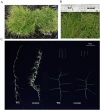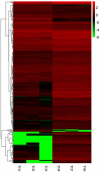Analysis of a radiation-induced dwarf mutant of a warm-season turf grass reveals potential mechanisms involved in the dwarfing mutant
- PMID: 33144613
- PMCID: PMC7609746
- DOI: 10.1038/s41598-020-75421-x
Analysis of a radiation-induced dwarf mutant of a warm-season turf grass reveals potential mechanisms involved in the dwarfing mutant
Abstract
Zoysia matrella [L.] Merr. is a widely cultivated warm-season turf grass in subtropical and tropical areas. Dwarf varieties of Z. matrella are attractive to growers because they often reduce lawn mowing frequencies. In this study, we describe a dwarf mutant of Z. matrella induced from the 60Co-γ-irradiated calluses. We conducted morphological test and physiological, biochemical and transcriptional analyses to reveal the dwarfing mechanism in the mutant. Phenotypically, the dwarf mutant showed shorter stems, wider leaves, lower canopy height, and a darker green color than the wild type (WT) control under the greenhouse conditions. Physiologically, we found that the phenotypic changes of the dwarf mutant were associated with the physiological responses in catalase, guaiacol peroxidase, superoxide dismutase, soluble protein, lignin, chlorophyll, and electric conductivity. Of the four endogenous hormones measured in leaves, both indole-3-acetic acid and abscisic acid contents were decreased in the mutant, whereas the contents of gibberellin and brassinosteroid showed no difference between the mutant and the WT control. A transcriptomic comparison between the dwarf mutant and the WT leaves revealed 360 differentially-expressed genes (DEGs), including 62 up-regulated and 298 down-regulated unigenes. The major DEGs related to auxin transportation (e.g., PIN-FORMED1) and cell wall development (i.e., CELLULOSE SYNTHASE1) and expansin homologous genes were all down-regulated, indicating their potential contribution to the phenotypic changes observed in the dwarf mutant. Overall, the results provide information to facilitate a better understanding of the dwarfing mechanism in grasses at physiological and transcript levels. In addition, the results suggest that manipulation of auxin biosynthetic pathway genes can be an effective approach for dwarfing breeding of turf grasses.
Conflict of interest statement
The authors declare no competing interests.
Figures







References
-
- Chen S, et al. In vitro selection of salt tolerant variants following 60Co gamma irradiation of long-term callus cultures of Zoysia matrella [L.] Merr. Plant Cell Tissue Organ Cult. 2011;107:493–500.
-
- Tanaka H, et al. The complete chloroplast genome sequence of Zoysia matrella [L.] Merr. Crop Sci. 2016;56:1206–1212.
-
- Choi JS, Ahn BJ, Yang GM. Distribution of native zoysiagrasses (Zoysia spp.) in the south and west coastal regions of Korea and classification using morphological characteristics. J. Korean Soc. Hortic. Sci. 1997;38:399–407.
-
- Larkin PJ, Scowcroft WR. Somaclonal variation—A novel source of variability from cell cultures for plant improvement. Theor. Appl. Genet. 1981;60:197–214. - PubMed
-
- Dale PJ. Meristem tip culture in lolium, festuca, phleum and dactylis. Plant Sci. Lett. 1977;9:333–338.
Publication types
MeSH terms
Substances
LinkOut - more resources
Full Text Sources

